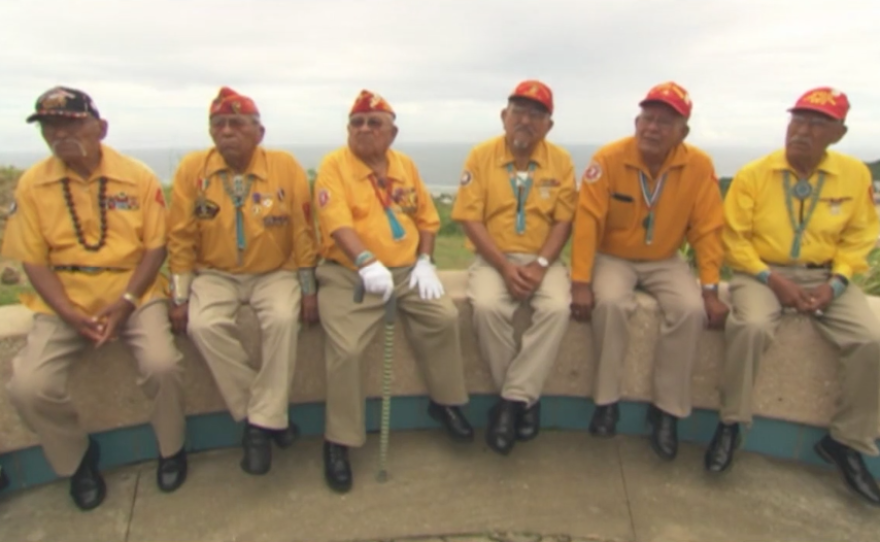Struck one of the longest held secrets of World War II involve native American soldiers and the code that was developed using the unwritten Navajo language. It was used to transmit messages in the Pacific. Forces were unable to crack it. One of the most amazing things was that there was anyone left in the 1940s who could still speak the Navajo language, considering how the US tried to wipe it out. Two soldiers remembered.When I came to school, they told me, you cannot speak Navajo in class now. You have to speak English. How was I going to speak English? I do not know nothing about English?They used to punish me when I spoke my own language. 13 years later, they asked me to use my language. And I asked that question. You told me to forget it, how come you wanted? That is the time they started saying please. We need you. We need you for your language.That is a clip from a documentary on that Navajo code talkers. That is screening this week on the 75th anniversary of the code talker program. Joining me is the producer and director of the film, a journey of remembrance. Welcome to the program.Thank you. It is good to be here.Matthew joins us with the history Center. Welcome.Thank you.George, the "Navajo Code Talkers: A Journey of Rememberance" was a secret. Why was that?As you know, the World War II, it quickly evolved into the Cold War. The code created by young Navajo recruits was not broken. The only oral code of World War II, they knew they had a great weapon. The weapon was used successfully on the island hopping campaign of the US Marines.Members of the Navajo code talker program for recruited in Arizona. They came to San Diego where they received training. Give us a sense about how the code worked and why it was so difficult to break.The greatest misunderstanding about the Navajo code has to do with the fact that it was a secret language within their unwritten language. For example, they used the English alphabet as the basis of constructing the way you were going to talk to a commander or in the battle. A was aunt. And the Navajo language, it was sushi. The first word of the message is A. That went into their head. This was never written down. B was bear. It had a phonetic spelling. They would produce a code based on the English language alphabet from their unwritten language. They did it in their heads.In the documentary, a Navajo code talkers, six code talkers as only men traveled to Meijer battlefields in the Pacific where the code made a crucial difference. Why did you feel it was important to go back there? Back I learned because of my close affiliation, it was part of the Native American religion. Their religion was as warriors, you do not go back where there was death and destruction. I had to sell the program that this was their legacy. I was able to persuade six code talkers and six family members, the younger generation to go back to the battlefields.What was that like?On the battlefields, they opened up to younger generations.Matt, do you think this is a part of San Diego history, military history, at the public is not familiar with?I do. These are the opportunities we look forward, people tell these little-known stories about San Diego. It turned out to be four short years where see Antigo went through a massive transformation. People can tell you about it. Of all the stories that came out of this, this is poignant because it has been a rough relationship with native Americans and the US military since the 19th century. Here are individuals who sacrifice a lot to help win the war for a country that had not been that receptive to them. These are stories that deserve to be told. We are happy to do it. It is something San Diegan should No.George, you filmed the documentary several years ago. Out just toTwo are -- to the families feel they got the credit they deserve? Back one of the speakers on Monday night in Phoenix at the Museum asked something similar. The response was, the code talkers were not looking forth thanks. They were not looking for credit. As a tribe that prides itself on its warrior heritage, they are surprisingly modest. They were very proud of the fact that they kept the secret.The film, "Navajo Code Talkers: A Journey of Rememberance" will be screened tonight at 530 at the San Diego history Center in Balboa Park. I have been speaking with the producer and director, George Colburn and Matthew. Thank you both very much.Thank you.
One of the longest-held secrets of World War II involved Native American soldiers and the code that was developed using the unwritten Navajo language. The secret code was used to transmit messages about U.S. operations in the Pacific. Japanese forces were unable to crack it.
A new documentary screening in San Diego Wednesday followed members of the Navajo Nation who served in WWII as they returned to major battlefields in the Pacific. The Navajo code talkers were trained and learned the secret code in San Diego.
George Colburn, producer and director of the film, "Navajo Code Talkers: A Journey of Remembrance," and Matthew Schiff with the San Diego History Center discuss the legacy of the Navajo code talkers, Wednesday on Midday Edition.
Film Screening
When: Wednesday 5:30-7:45 p.m.
Where: San Diego History Center in Balboa Park
Cost: $5-$10







